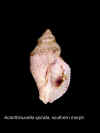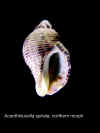Study of Marine Snail Suggests Conservation Efforts Should Consider Factors Beyond Genetic Diversity
MAY 31, 2001
By Kim McDonald
A study of climate-induced evolutionary change in a California intertidal snail suggests that resource managers shouldn’t focus exclusively on genetic diversity when developing conservation plans for protecting endangered or threatened species.
In the study, detailed in the June 1 issue of Science, biologists at the University of California, San Diego and at Louisiana State University measured the genetic diversity of populations of Acanthinucella spirata, a common marine gastropod, from Tomales Bay, 40 miles north of San Francisco, to San Diego. They discovered that the snail’s genetic diversity, the most commonly used gauge of a population’s health, is highest in the Los Angeles area and lowest in the northern part of its range.
Measurements of genetic diversity now greatly influence decisions on where to locate protected reserves, since the most genetically diverse populations are assumed to be better able to withstand environmental changes. But while the snails around Los Angeles and to the south are genetically more diverse than those to the north, the researchers discovered that they are less diverse morphologically. This is due to the presence of a different shell form, or morphology, in some populations in the northern part of the range that is not found in the Los Angeles area or in regions to the south.
"There’s a big difference in the morphology—in the shape and size of the shells—between the northern and the southern populations," says Kaustuv Roy, an assistant professor of biology at UCSD who conducted the study with Michael E. Hellberg, an assistant professor of biology at LSU, and Deborah P. Balch, a former student at UCSD.
"Looking at the coast today, there’s a dramatic decline in genetic diversity in this species going from south to north," he adds. "But the northern regions have a greater amount of morphological diversity. So, which do you use to make conservation decisions—genetic diversity or morphological diversity? Here’s a case where the two come into conflict."
In their study, which was supported by the National Science Foundation, the scientists assessed the genetic diversity of 14 populations of the snail by analyzing the variation in a mitochondrial DNA sequence from 117 individuals. The researchers then compared the sizes and shapes of the snail’s shells, which range from 15 to more than 30 millimeters in length, in each population with fossil shells of the same species found in coastal sediments dating back to the late Pleistocene (125,000 to 11,000 years ago) and even earlier, when the planet went through a series of ice ages.
During those ice ages, the cooling of the planet caused localized extinctions of many populations of marine and terrestrial organisms near the northern limits of their ranges. When the earth warmed, some of the southern populations re-colonized the previously occupied northern regions.
This is what the scientists believe happened to Acanthinucella spirata, because the snail’s genetic diversity is highest around Los Angeles and declines sharply northward. The decline in genetic diversity suggests that the northern part of the range of this marine snail was re-colonized by a small number of individuals from the south, resulting in genetically homogeneous populations to the north.
During one of those re-colonizations, some 12,000 to 30,000 years ago, a new form of Acanthinucella spirata evolved to the north with a thick, short and broad shell.
The researchers obtained their estimates on when this new morphological type arose by calculating the changes over time in a protein they used as a "molecular clock." They also confirmed from their fossil collections that this second distinct morphology was not present along the California coast before this time period.
"The difference is apparent to anyone collecting in the field," says Roy, because the new form has shells that are clearly shorter, thicker and broader than the shells found to the south or in fossil deposits. If Acanthinucella spirata was a threatened species, he adds, efforts to protect only populations that are genetically diverse would risk eliminating this distinct shell form.
"When adaptive evolution happens, it happens quickly," says Hellberg of LSU. "As a result, the neutral genetic markers commonly used for assessing population uniqueness may not always spot populations with novel adaptive characteristics worth preserving."
Photographs of the two forms of Acanthinucella spirata available at: http://ucsdnews.ucsd.edu/newsrel/science/mcshell.htm


